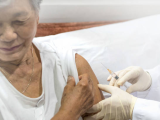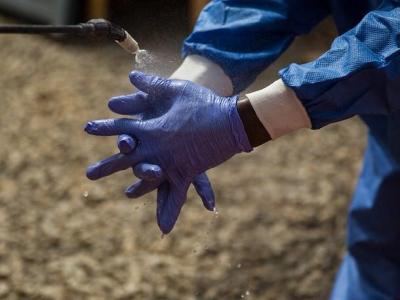Apr 1, 2010 (CIDRAP News) – Although less than 40% of healthcare workers have received the pandemic flu vaccine, federal officials see promising signs about uptake of the seasonal vaccine and strategies for boosting vaccination rates in this group.
The findings are from the US Centers for Disease Control and Prevention's (CDC's) initial review of flu vaccine uptake in healthcare workers, published today in the Apr 2 issue of Morbidity and Mortality Weekly Report (MMWR).
According to Internet surveys of healthcare workers that the CDC has been conducting in collaboration with the Rand Corporation, by mid January coverage in healthcare workers was almost 62% for the seasonal flu vaccine but just 37% for the pandemic vaccine. Overall, 64.3% had received one of the two vaccines, higher than in any previous season. However, only 34.7% of healthcare workers received both flu vaccines.
Though yearly flu vaccines are widely hailed as a tool to protect healthcare workers and their patients, uptake rates in this group have never been as high as health officials have hoped and have never pushed past 49%. Some institutions have made flu vaccination mandatory, but those policies have been controversial.
The CDC and Rand based their estimates on 1,417 respondents who reported working in healthcare settings or who were involved directly in patient care. They found that seasonal and pandemic flu vaccination rates were higher in those who worked in hospitals compared with those who worked in other settings, such as outpatient clinics or nursing homes.
Those who worked in intensive care, burn, or obstetric units were more likely than other healthcare workers to receive both the seasonal and pandemic vaccines.
Healthcare workers were more likely to believe that the seasonal flu vaccine was safe when compared to the pandemic vaccine. More workers believed the seasonal flu vaccine was more worth the time and expense than the pandemic vaccine counterpart.
Despite the early-October, later-than-expected arrival of the pandemic vaccine and the high, early demand for the seasonal vaccine, unavailability was the reason given for 17.3% of healthcare workers who didn't get the pandemic vaccine and 7.4% who didn't get the seasonal flu vaccine. The two most common reasons for not getting one or the other vaccines is the view that it wasn't needed and fear of side effects,
Employee requirements were strongly linked to higher uptake rates for both vaccines. The increase was twofold in those required to get the seasonal vaccine and eightfold in those required getting the pandemic vaccine. The seasonal vaccine was required by employers of 11% of respondents, and the pandemic vaccine was required for 8.4%.
Institutional policies recommending both vaccines were also connected to higher uptake rates—nearly threefold for the seasonal vaccine and almost fourfold for the pandemic vaccine.
The CDC, in an editorial note that accompanied its report, noted that the uptake rate for the seasonal flu vaccine for the first time meets the federal Healthy People 2010 goal of 60%. The authors said influenza's higher profile resulting from the pandemic H1N1 virus may have helped boost seasonal vaccine coverage.
At a media briefing today to discuss the findings, plus another MMWR report on state flu vaccine uptake, Anne Schuchat, MD, head of the CDC National Center for Immunization and Respiratory Diseases, said higher vaccine uptake rates in institutions that have requirements and recommendations in place are useful for planning purposes.
"Having a systematic approach is a good way to make sure healthcare workers are protected and can protect their patients," she said.
She said federal officials hope to see healthcare worker vaccination rates rise in the years ahead, and noted that other strategies could be used to push uptake higher. For example, Schuchat said facilities could report and advertise their staff vaccination rates. "Maybe we're at the tipping point where patients and consumers demand this," she said of healthcare worker vaccination.
The finding that vaccination rates were higher in workers who care for high-risk groups in hospitals illustrates an important point, Schuchat said. "To me, this emphasizes that flu vaccination is a patient-safety issue."
In early January, the CDC first signaled that pandemic vaccine uptake in healthcare workers might be lower than expected. A Jan 22 MMWR report, citing very early data, suggested uptake was around 22%. In a January interview with CIDRAP News, Linda R. Greene, RN, MPS, CIC, a board member with the Association for Professionals in Infection Control and Epidemiology (APIC) and director of infection prevention and control at Rochester General Health System in Rochester, N.Y., said there was still time and opportunities for more healthcare workers to be vaccinated.
Vaccine delays may have tamped down vaccination rates in healthcare workers, just as they did with the general public, she said. "Some of the momentum was lost," Greene added.
Though healthcare workers were the top priority group to receive the first doses in early October, most of those doses were the inhaled version, which was contraindicated for some people with underlying conditions and those aged 50 and over, both of whom make up a sizable segment of the healthcare workforce, Greene said.
Dwindling flu activity was a challenge for infection control professionals who were working to vaccinate their staffs, she said. "When flu drops off the radar, healthcare workers are human, too. These are things that are difficult challenges."
In October the state of New York suspended state law requiring flu vaccines for healthcare workers, because the pandemic vaccine was late and more pandemic and seasonal vaccine doses were needed for high-risk groups. Many healthcare workers strongly oppose such mandates. "It will depend on local culture, but we'll see more mandates and institution-specific rules," Greene said.
The goals are for infection control experts to be good role models, spread the message about the importance of vaccination, and work to dispel myths that even healthcare workers have about flu vaccines, Greene said. "We need to show the data and tell the stories—personalize the information."
See also:
CDC. Interim results: influenza A (H1N1) 2009 monovalent and seasonal influenza vaccination coverage among healthcare personnel—United States, August 2009-January 2010. MMWR 2010 Apr 2;59(12):257-62 [Full text]
CDC. Interim results: influenza A (H1N1) 2009 monovalent vaccination coverage—United States, October-December 2009. MMWR 2010 Jan 22;59(2):44-8 [Full text]

















